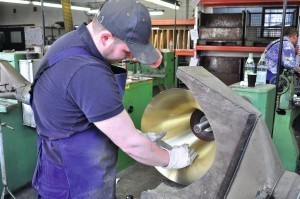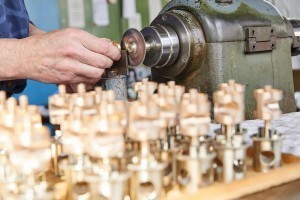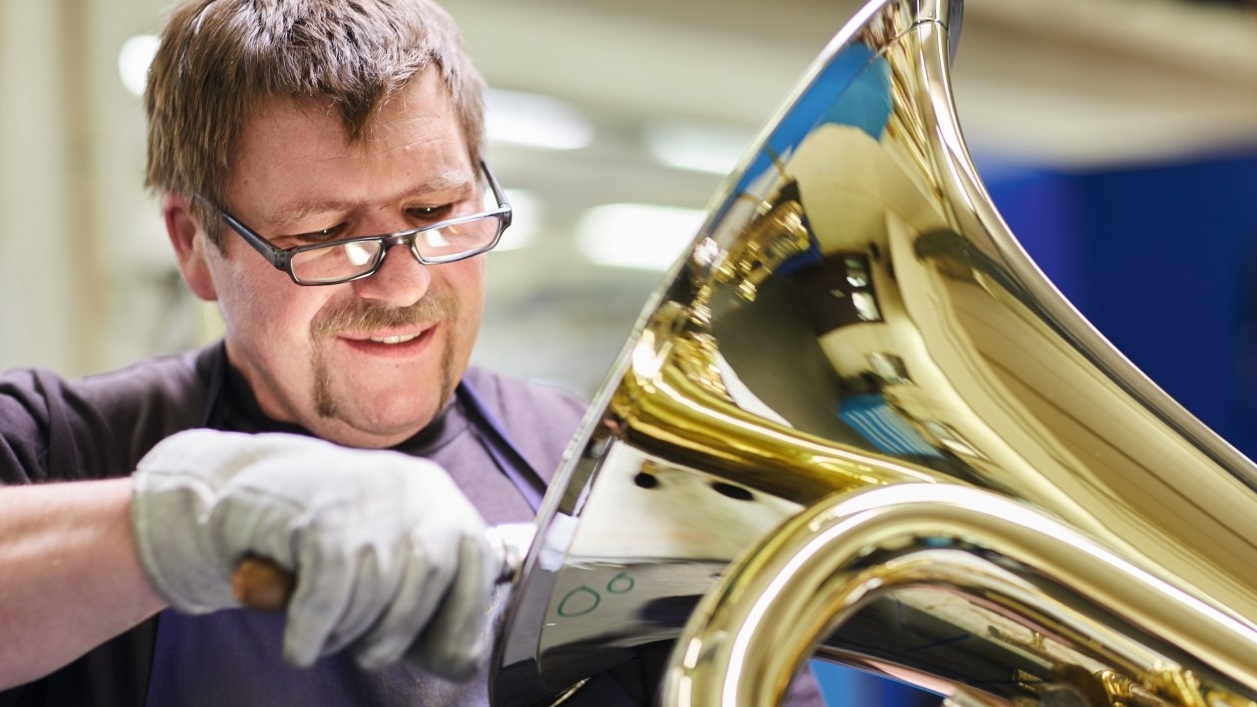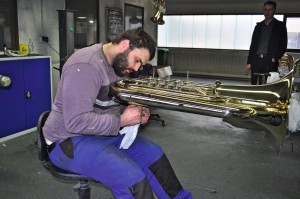In the world of music, the name Miraphone has an excellent reputation. The factory in Waldkraiburg, Upper Bavaria, is one of the largest - and noblest - manufacturers of brass instruments in the world.
Even in the age of electric guitars and synthesizers, rap and techno, the sound of brass instruments has retained its magic. Many of our contemporaries are delighted by the traditional appearance of the trumpeters from Kastelruth. At Christmas, baroque trumpet music blares from the church towers. And some people dream of long-gone, Wilhelmine greatness to the sound of the military band marching past.
Comrades instead of employees
 The later shape of the bell is created on a rotating chuck - surface treatment includedThe deadlive longer and the fact that trombone choirs, music clubs and Dixieland combos are experiencing a renaissance is probably also due in part to the Miraphone brand. The company produces high-quality wind instruments that are not cheap but - 100% made in Germany - meet all the requirements of professional musicians.
The later shape of the bell is created on a rotating chuck - surface treatment includedThe deadlive longer and the fact that trombone choirs, music clubs and Dixieland combos are experiencing a renaissance is probably also due in part to the Miraphone brand. The company produces high-quality wind instruments that are not cheap but - 100% made in Germany - meet all the requirements of professional musicians.
The factory in Waldkraiburg produces trumpets and flugelhorns, baritones and tenor horns, trombones, euphoniums and tubas. CEO Christian Niedermaier: "If you like, we are one of the few instrument manufacturers in the world to produce bass tubas on this scale. Around 50% of our production are tubas of various basic tunings." However, Miraphone does not produce any woodwind instruments.
If a young person decides to complete an apprenticeship at Miraphone, for example as a metal wind instrument maker, it is often a decision for life. Miraphone is organized as a cooperative and employees, currently 90 in total, can become co-owners of the company if they wish. Perhaps this special employee-company relationship is the reason why the people of Waldkraiburg are particularly motivated to deliver exceptional quality. What's more, most of the employees play a wind instrument themselves. It is a matter of honor that this comes from their own company.
Incidentally, the quality has historical roots. The company was founded in 1946 by 13 musical instrument makers from the Sudeten German town of Graslitz (now Kraslice). Graslitz was the center of German musical instrument making until the end of the Second World War. The Germans were expelled by the Benes Decrees. Many of them settled in Waldkraiburg and brought extensive know-how with them.
At the beginning of the production process of a metal wind instrument is the sheet metal. Brass is the first choice, in various thicknesses depending on the type of instrument. Using a template, the basic shape of the bell is scribed onto a brass plate and cut out. The three-dimensional bell is then formed by hand from the two-dimensional piece of sheet metal. Where the edges meet, they are carefully interlocked, soldered and hammered together. This is done so skillfully that the seam is no longer visible on the finished instrument.
The longer an instrument, the deeper it sounds
 Valve production is precision work. The bell is then placed on a rotating mold, where it is given its final appearance. Among other things, the edge of the funnel is flanged for greater stability and sound quality. An initial surface treatment is also carried out.
Valve production is precision work. The bell is then placed on a rotating mold, where it is given its final appearance. Among other things, the edge of the funnel is flanged for greater stability and sound quality. An initial surface treatment is also carried out.
In the meantime, other employees produce the tuning bows for the instrument on a corresponding bending device. The result is rather large-diameter bows and very small ones with very narrow diameters and various lengths. The purpose of these tuning bows is to give the air column inside the instrument a different path by actuating the valves. This makes the air flow longer or shorter, resulting in different high notes. A longer path means a lower tone, a shorter path means a higher tone.
Christian Niedermaier: "These valves were not invented until around 1830. Before that, the different tones had to be produced by what is known as plugging. The musician closed the bell of the instrument more or less effectively with one hand. It was a difficult and strenuous way of making music."
Today, there are two main valve systems used on trumpets, horns and other instruments. The wing valve, also known as the rotary valve, or the Périnet valve, also known as the pump valve. Both types have the same effect. Which system the musician chooses is up to his taste - and the type of music.
A tied legato is easier to play on a rotary valve. With a pump valve, on the other hand, the air column is interrupted, the individual notes are clearer, but you can also "flick" the notes, a quality that is particularly in demand in jazz music.
Polishing is hard work - only large surfaces are polished by machine
During the assembly of the instrument, the various parts are polished again and again. However, the material becomes dark and unsightly again due to the heating during various soldering processes.
The final surface treatment therefore only takes place after all the parts have been completely soldered together. And this requires a lot of sweaty manual work. Machines can only be used to a limited extent in the tight corners and loops of an instrument, so the good old polishing cloth is very useful here. Large surfaces are machined.
90 % of the parts are painted, only 10 % are galvanized
 CEO Christian Niedermaier is optimistic about the future Finally, the instrument is coated. Niedermaier: "90 percent of all metal wind instruments are varnished. Only around 10 percent are electroplated. Silver dominates here." In fact, 9 out of 10 of the electroplated instruments are silver-plated - not least because of the price. This is why it is mainly the small pieces that are plated. Niedermaier explains: "Suppose you wanted to have a bass tuba gold-plated. As this never happens in practice, the electroplater would have to prepare an extra gold bath and in a size that does justice to the tuba. My estimate is between 5,000 and 7,000 euros - in addition to the price of the instrument."
CEO Christian Niedermaier is optimistic about the future Finally, the instrument is coated. Niedermaier: "90 percent of all metal wind instruments are varnished. Only around 10 percent are electroplated. Silver dominates here." In fact, 9 out of 10 of the electroplated instruments are silver-plated - not least because of the price. This is why it is mainly the small pieces that are plated. Niedermaier explains: "Suppose you wanted to have a bass tuba gold-plated. As this never happens in practice, the electroplater would have to prepare an extra gold bath and in a size that does justice to the tuba. My estimate is between 5,000 and 7,000 euros - in addition to the price of the instrument."
While the final work step of lacquering is also carried out in Waldkraiburg - a corresponding lacquering booth is integrated into the production process - the instruments to be electroplated are sent outside the company to a specialist - ÖGUSSA in Vienna has taken on this task for Miraphone.
For the musician, this raises the question of whether the application of a layer changes the sound quality of the instrument. "Yes," answers Niedermaier. "But the sound doesn't get worse, it just gets different. And that's mainly a question of taste."
INFO
The basic tuning of the instruments
For the fundamental tone of the instrument, half the wavelength is approximately equal to the length of the tube. This determines the basic tuning. The frequency f (unit of measurement Hertz, Hz) is related to the tube length l (measured in meters) and the speed of sound c in air (measured e.g. in meters per second) according to the equation
![]()
From this, the length can be approximately calculated for a given frequency (pitch) or, conversely, the frequency can be calculated for the length.
As a rule of thumb, the shorter an instrument is, the higher it sounds. A Bb piccolo trumpet is around 65 cm long and is therefore an octave above the normal Bb trumpet, which is around 1.30 meters long. The Bb tenor horn, which is almost 2.70 meters long, is an octave lower.
INFO
Miraphone at a glance
Miraphone was founded in Waldkraiburg in 1946. 13 instrument makers displaced from Graslitz (Kraslice) in the Czech Republic after the Second World War joined forces. The company is organized as a cooperative, i.e. each of the 90 employees is a co-owner of the company.
The portfolio includes tubas (50% of the production volume), trumpets, flugelhorns, baritones, tenor horns, trombones and euphoniums - all in the premium range. Sales figures are not disclosed.




